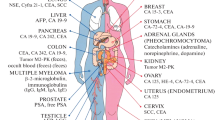Abstract
The ability to distinguish tumor cells from normal cells is vital to allow the immune system to selectively destroy tumor cells. In order to find an effective marker, we used enzyme-linked immunosorbent assay, immunocytochemistry, immunofluorescence, and flow cytometry to investigate the effects of heat stress on the amount of heat shock protein 70 on the surface of tumor cells (Hep G2 cells). Heat shock protein 70 is the major stress-induced heat shock protein found on the surface of tumor cells. Our results indicate that the percentage of Hep G2 cells with a detectable level of heat shock protein 70 on their cell surface increased significantly (P < 0.05) following heat stress at 42 °C for 2 h (up to 1.92 times the level before heat treatment). The detectable level of heat shock protein 70 on the surface of Hep G2 cells reached its peak 12 h after treatment. However, the fluorescent intensity of stressed and unstressed Hep G2 cells was not significantly different (P > 0.05). The increase in the level of heat shock protein 70 on the surface of tumor cells following heat stress could provide a basis for finding novel immunotoxins as targets for drug action and may have application to be used in conjunction with hyperthermia in the treatment of tumors.




Similar content being viewed by others
References
Parcellier A, Gurbuxani S, Schmitt E, Solary E, Garrido C. Heat shock proteins, cellular chaperones that modulate mitochondrial cell death pathways. Biochem Biophys Res Commun. 2003;304:505–12.
Garrido C, Gurbuxani S, Ravagnan L, Kroemer G. Heat shock proteins: endogenous modulators of apoptotic cell death. Biochem Biophys Res Commun. 2001;286:433–42.
Javid B, MacAry PA, Lehner PJ. Structure and function: heat shock proteins and adaptive immunity. J Immunol. 2007;179:2035–40.
Calderwood SK, Khaleque MA, Sawyer DB, Ciocca DR. Heat shock proteins in cancer: chaperones of tumorigenesis. Trends Biochem Sci. 2006;31:164–72.
Badowska-Kozakiewicz AM, Malicka E. Immunohistochemical evaluation of expression of heat shock proteins HSP70 and HSP90 in mammary gland neoplasms in bitches. Pol J Vet Sci. 2012;15:209–14.
Jaattela M. Escaping cell death: survival proteins in cancer. Exp Cell Res. 1999;248:30–43.
Multhoff G, Botzler C, Wiesnet M, Müller E, Meier T, Wilmanns W, et al. A stress-inducible 72-kDa heat-shock protein (HSP72) is expressed on the surface of human tumor cells, but not on normal cells. Int J Cancer. 1995;61:272–9.
Shin BK, Wang H, Yim AM, Le Naour F, Brichory F, Jang JH, et al. Global profiling of the cell surface proteome of cancer cells uncovers an abundance of proteins with chaperone function. J Biol Chem. 2003;278:7607–16.
Zheng H, Dai J, Stoilova D, Li Z, et al. Cell surface targeting of heat shock protein gp96 induces dendritic cell maturation and antitumor immunity. J Immunol. 2001;167:6731–5.
Chen X, Tao Q, Yu H, Zhang L, Cao X. Tumor cell membrane-bound heat shock protein 70 elicits antitumor immunity. Immunol Lett. 2002;84:81–7.
Niyazi M, Maihoefer C, Krause M, Rödel C, Budach W, Belka C. Radiotherapy and “new” drugs—new side effects? Radiat Oncol. 2011;6:177.
Bai XF, Liu J, Li O, Zheng P, Liu Y. Antigenic drift as a mechanism for tumor evasion of destruction by cytolytic T lymphocytes. J Clin Invest. 2003;111:1487–96.
Vega VL, Rodríguez-Silva M, Frey T, Gehrmann M, Diaz JC, Steinem C. Heat shock protein70 translocates into the plasma membrane after stress and is released into the extracellular environment in a membrane-associated form that activates macrophages. J Immunol. 2008;180:4299–307.
Acknowledgments
We thank Dr. Alan K Chang (Dalian University of Technology, Dalian, China) for critical discussion and correction of the manuscript.
Conflicts of interest
None
Author information
Authors and Affiliations
Corresponding author
Rights and permissions
About this article
Cite this article
Cui, N., Xu, Y., Cao, Z. et al. Effects of heat stress on the level of heat shock protein 70 on the surface of hepatocellular carcinoma Hep G2 cells: implications for the treatment of tumors. Tumor Biol. 34, 743–748 (2013). https://doi.org/10.1007/s13277-012-0603-0
Received:
Accepted:
Published:
Issue Date:
DOI: https://doi.org/10.1007/s13277-012-0603-0




